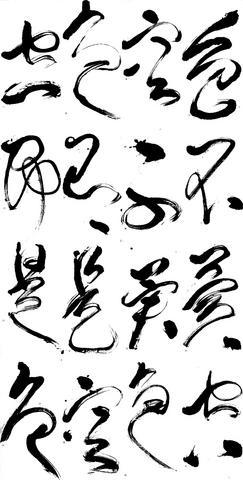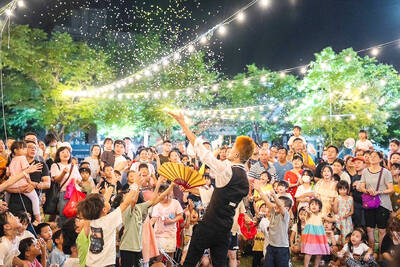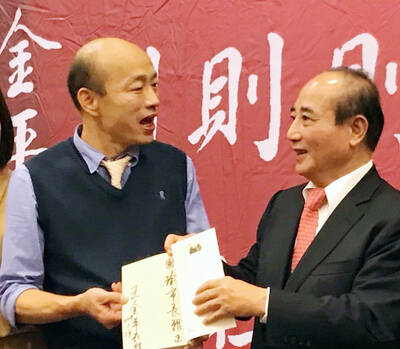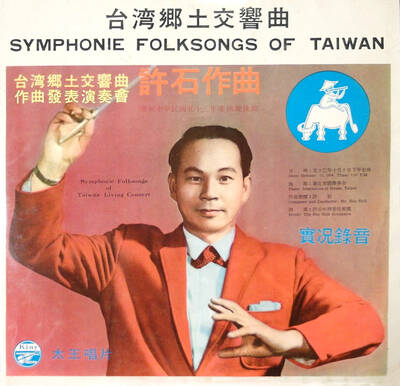In addition to being a symbol of traditional Chinese culture, calligraphy is also becoming a popular contemporary art form. This is skillfully illustrated in a multimedia exhibition that integrates architecture, interior design and Chinese characters. Calligraphy artist Tong Yang-tze (
With a background in photography, Tong turned her attention to calligraphy in the 1990s. Since then she has taken on several projects with the intention of attracting a new and younger audience. The integration of modern media like graphic and interior design in her work has led to collaborations with various artists, including two previous projects with Chen in 2000 and 2002.

PHOTO COURTESY OF TAIPEI FINE ARTS MUSEUM
Chen, famed for his simple architecture, has received plaudits in both Taiwan and Japan. He avoids lurid and aggressive designs by using only black and white with minimal fixtures.
His modest designs complement Tong's dramatic brush strokes and illustrate just how rich and powerful calligraphy as an art form can be. The show has been divided into three gallery spaces, each with its own unique spatial design and suitably selected passages from classical Chinese literature and religious texts.
In Gallery D, Opening Poem of the Romance of the Three Kingdoms is a work across a 56m scroll. The entire text wraps around an oval wall approximately 8m in height. The room is covered in sand, which, set against the soft and natural lighting, creates a feeling of walking through a garden during the daytime.
Upon entering Gallery F, viewers are taken to another courtyard scene, only now the bright lighting has been replaced with limited lighting from a few candles, which gives the effect of moonlight. Five mirror-topped coffee tables have been positioned around the room to create a maze-like garden space for viewers to walk around. The exaggerated brush strokes make the characters almost unrecogni-zable, as they are reflected in the mirrors.
The third exhibit in Gallery E is a video installation employing the talents of Hong Kong graphic designer, Mathias Woo.
More recently known for his scriptwriting endeavors, Woo has also designed multimedia stage productions for Taiwanese director Stan Lai. Here, Tong plays with different combinations of six characters taken from a central Buddhist teaching in the Heart Sutra.
Using both clerical and grass scripts, the characters are projected onto the wall, ceiling and floor, encompassing the entire room. As viewers step into and around the space, their shadows are projected among the shifting characters, making the viewers a part of the installation.
Described as "digital calligraphy" the juxtaposition of modern technology with the traditional form of writing gives new life to a fading practice. By combing elements of design, architecture and calligraphy in the exhibition, the two artists provide an innovative way of viewing the written Chinese language.
Exhibition notes:
What: Realm of Feelings: A Dialogue of Calligraphy and Space by Tong Yang-tze and Ray Chen with multi-media design by Mathis Woo.
Where: In the basement galleries D, E, F at the Taipei Fine Arts Museum (台北市立美術館) located at 181 Zhongshan N Rd, Sec 3, Taipei (臺北市中山北路3段181號).
Telephone: (02) 2595-7656
When: 9:30am to 5:30pm, Tuesday to Sunday (closed Mondays). Until Dec. 5.

The depressing numbers continue to pile up, like casualty lists after a lost battle. This week, after the government announced the 19th straight month of population decline, the Ministry of the Interior said that Taiwan is expected to lose 6.67 million workers in two waves of retirement over the next 15 years. According to the Ministry of Labor (MOL), Taiwan has a workforce of 11.6 million (as of July). The over-15 population was 20.244 million last year. EARLY RETIREMENT Early retirement is going to make these waves a tsunami. According to the Directorate General of Budget Accounting and Statistics (DGBAS), the

Many will be surprised to discover that the electoral voting numbers in recent elections do not entirely line up with what the actual voting results show. Swing voters decide elections, but in recent elections, the results offer a different and surprisingly consistent message. And there is one overarching theme: a very democratic preference for balance. SOME CAVEATS Putting a number on the number of swing voters is surprisingly slippery. Because swing voters favor different parties depending on the type of election, it is hard to separate die-hard voters leaning towards one party or the other. Complicating matters is that some voters are

Sept 22 to Sept 28 Hsu Hsih (許石) never forgot the international student gathering he attended in Japan, where participants were asked to sing a folk song from their homeland. When it came to the Taiwanese students, they looked at each other, unable to recall a single tune. Taiwan doesn’t have folk songs, they said. Their classmates were incredulous: “How can that be? How can a place have no folk songs?” The experience deeply embarrassed Hsu, who was studying music. After returning to Taiwan in 1946, he set out to collect the island’s forgotten tunes, from Hoklo (Taiwanese) epics to operatic

Five years ago, on the verge of the first COVID lockdown, I wrote an article asking what seemed to be an extremely niche question: why do some people invert their controls when playing 3D games? A majority of players push down on the controller to make their onscreen character look down, and up to make them look up. But there is a sizable minority who do the opposite, controlling their avatars like a pilot controls a plane, pulling back to go up. For most modern games, this requires going into the settings and reconfiguring the default controls. Why do they